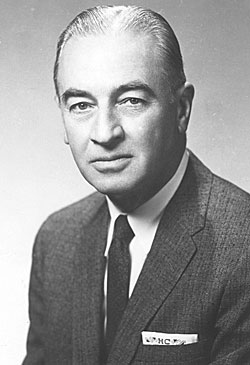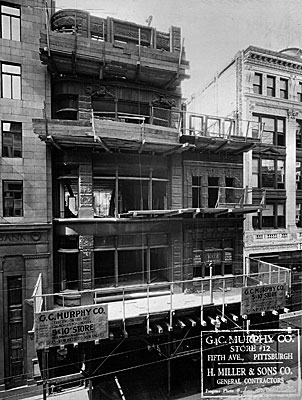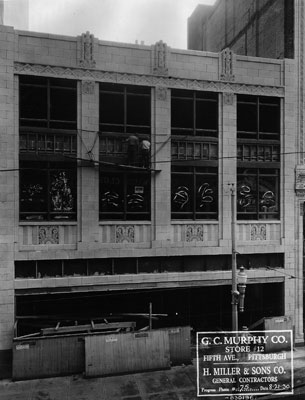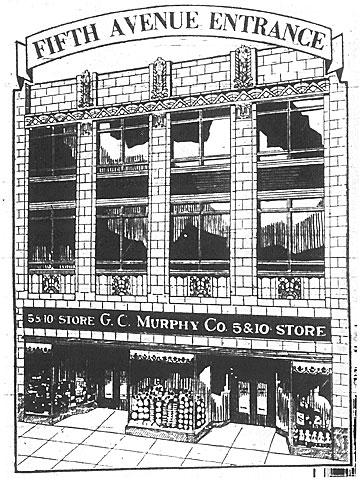 |
 |
 |
 |
Heinz History Center Downloads
THIS PAGE IS FOR USE BY HSWP/HEINZ PERSONNEL ONLY.
PLEASE DO NOT LINK TO THIS PAGE FROM PUBLIC WEBSITES.
| Photos
(right-click and "Save Link As ..." to download)
|
|
Caption
|
|
|
 |
This August 1946 cover of Chain Store Age magazine, a major trade publication that then covered the five-and-10 or "variety store" industry, featured the Fifth Avenue facade of G.C. Murphy Co.'s Downtown Pittsburgh store.
The image shows (at left) both the 1930 structure designed by Murphy Architect Harold Crosby and (at right) the neighboring Bedell Co. clothing store, which was acquired by Murphy's and added to the store in 1940.
Crosby then designed a new light pink storefront to tie the two buildings together.
(CREDIT: Copyright Lebhar-Friedman, Inc. Reproduced with permission.)
(IMAGE: 17.4MB TIFF, 2400 by 3197 px)
|
 |
|
|
 |
|
This image from the G.C. Murphy Co.'s 1973 annual report shows the Fifth Avenue facade as it appeared after the 1950s.
(Credit: G.C. Murphy Co. photo, courtesy Clair A. McElhinny.)
(IMAGE: 12.3MB TIFF, 3000 by 2154 px.)
|
 |
|
|
 |
|
Harold E. Crosby, a 1922 graduate of Iowa State College, joined the G.C. Murphy Co. in the late 1920s and became its chief architect. He rose to vice president of construction and real estate before his death in 1958.
In 1930, Crosby created Murphy's block-wide store between Fifth Avenue and Diamond Street by reusing three older buildings and connecting them with a new three-story steel frame structure. Building and equipping the store cost more than $661,000, according to Murphy records at the McKeesport Heritage Center.
(CREDIT: G.C. Murphy Co. photo courtesy Edwin W. Davis.)
(IMAGE: 828 KB TIFF, 946 by 1382 px.)
|
 |
|
|
 |
|
Construction of G.C. Murphy Co. Store No. 12 began with the demolition of several older buildings between Fifth Avenue and Diamond Street near McMasters Way, including these structures between the Exchange National Bank and the Bedell Co. clothing store on Fifth Avenue.
(CREDIT: G.C. Murphy Co. photo, courtesy McKeesport Heritage Center, McKeesport, Pa.)
(IMAGE: 4.9 MB TIFF, 2069 by 2740 px.)
|
 |
|
|
 |
|
Murphy Architect Crosby crafted the new store by connecting a new three-story steel frame structure to several older, existing buildings.
(CREDIT: G.C. Murphy Co. photo, courtesy McKeesport Heritage Center, McKeesport, Pa.)
(IMAGE: 5.1 MB TIFF, 2719 by 2045 px.)
|
 |
|
|
 |
|
Two months after demolition began at the site, steel erection was well underway. The building was completed in about 70 days, or three months ahead of schedule — "a record in speedy construction," according to one contemporary account.
(CREDIT: G.C. Murphy Co. photo, courtesy McKeesport Heritage Center, McKeesport, Pa.)
(IMAGE: 4.9 MB TIFF, 2079 by 2719 px.)
|
 |
|
|
 |
|
The new Diamond Street facade of G.C. Murphy Co.'s Store No. 12 begins to take shape.
(CREDIT: G.C. Murphy Co. photo, courtesy McKeesport Heritage Center, McKeesport, Pa.)
(IMAGE: 4.6 MB TIFF, 2716 by 2057 px.)
|
 |
|
|
 |
|
The Fifth Avenue facade of Store No. 12 nears completion in August, 1930. Architectural historian Albert Tannler, writing in the Tribune-Review, praised the "fully developed Art Deco terra cotta ornamentation" on the facades designed by Crosby for Fifth and Diamond streets. "Above the third-floor windows, a band of half-circles (the rising sun?) peak out from behind triangles decorated with cubes and tiny triangles tinted salmon and green," Tannler wrote in 2000. "Above, four frozen fountains jet upward past the roof line from a bed of lush vegetation. Panels of stylized ferns and flowers dot the facade." (Tribune-Review Focus Magazine, March 26, 2000, p. 10)
(CREDIT: G.C. Murphy Co. photo, courtesy McKeesport Heritage Center, McKeesport, Pa.)
(IMAGE: 5.1 MB TIFF, 2157 by 2832 px.)
|
 |
|
|
 |
|
Ads in all three Pittsburgh daily newspapers invited customers to tour the new store at a special "inspection day" before its official Oct. 16, 1930 grand opening.
In the ads, the McKeesport-based Murphy chain said the new store — the company's 170th — gave it "particular satisfaction."
"We consider this store a monument to our success and to the progressive city that first sponsored that success," the ads said.
(CREDIT: Author's collection)
(IMAGE: 2.3 MB TIFF, 1686 by 3000 px)
|
 |
|
|
 |
|
Detail of linecut from above advertisement.
(CREDIT: Author's collection)
(IMAGE: 2.2 MB TIFF, 1500 by 1997 px)
|
 |
|
|
 |
|
Detail of linecut from above advertisement.
(CREDIT: Author's collection)
(IMAGE: 1.6 MB TIFF, 1350 by 1334 px)
|
 |
|
|
 |
|
Perhaps one of the best-remembered features of G.C. Murphy Co.'s "Store No. 12" are its restaurant, located downstairs, and its first-floor lunch counter and soda fountain. The 200-foot-long fountain was believed to be one of the largest in the world.
(CREDIT: Author's collection)
(IMAGE: 3.3 MB TIFF, 2400 by 1648 px)
|
 |
|
|
 |
|
Crowds line up on Fifth Avenue outside the G.C. Murphy Co.'s Store No. 12 to watch an employee make "submarine sandwiches" in this photo from the early 1950s.
(CREDIT: G.C. Murphy Co. photo, courtesy Ed Kinter.)
(IMAGE: 4 MB TIFF, 3000 by 2403 px)
|
 |
|
|
 |
|
G.C. Murphy Co. logo, used in the 1940s, mainly on internal documents.
(IMAGE: 1 MB TIFF, 950 by 950 px)
|
 |
|
|
 |
|
G.C. Murphy Co. logo used by stores and on corporate documents from 1960s through 1982/1983
(IMAGE: 1 MB TIFF, 750 by 750 px)
|
 |
|
|
 |
|
At its peak in the late 1940s, more than 375 people worked at G.C. Murphy Co.'s store in downtown Pittsburgh.
Until the 1960s, each department was filled with mahogany counters, topped with merchandise in glass-filled bins, and a sales clerk (always female) was assigned to each counter. This made five-and-10 operation extremely labor intensive.
Self-service displays and "checkout lines" eliminated separate counters in Murphy stores by 1970.
(IMAGE: 1.7 MB TIFF, 1662 by 1340 px)
|
 |
|
|
 |
|
At its peak in the late 1940s, more than 375 people worked at G.C. Murphy Co.'s store in downtown Pittsburgh.
Until the 1960s, each department was filled with mahogany counters, topped with merchandise in glass-filled bins, and a sales clerk (always female) was assigned to each counter. This made five-and-10 operation extremely labor intensive.
Self-service displays and "checkout lines" eliminated separate counters in Murphy stores by 1970.
This unidentified clerk was photographed for a 1948 G.C. Murphy Co. training manual called "The Spirit of Service."
(IMAGE: 1.7 MB TIFF, 1500 by 1221 px)
|
 |
|
|
|
 |
 |
 |
Copyright © 2004, 2005 G.C. Murphy Company Foundation Inc. This Website is not endorsed by or affiliated with Ames Department Stores Inc., McCrory Stores Corp., Riklis Family Holdings, or their subsidiaries, affiliates or successors.
TM— "G.C. Murphy Co." is a trademark of the G.C. Murphy Co. Foundation. Any other trademarks are property of their holders, and are used here for illustrative purposes only. Website hosting by SkyMagik Internet Services, McMurray, Pa. |
|
 |
|
|



